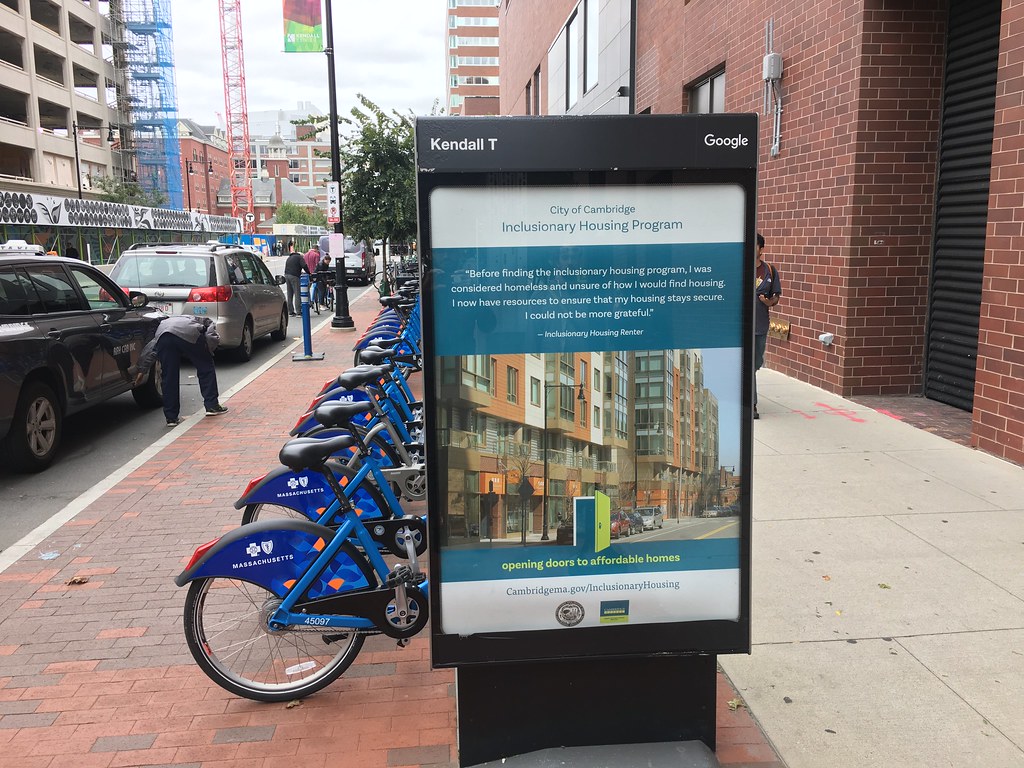Issues & Analyses: A Primer On Inclusionary Zoning

Cambridge, MA advertises its inclusionary zoning bylaw on a municipal sign board. Photo: Flckr.com. Creative Commons
by Kitty Axelson-Berry and Suzannah Muspratt
Inclusionary housing policies are a common tool for expanding local affordable rental housing options. These policies are already established in 27 states, including Massachusetts and the District of Columbia.
In Massachusetts, the Affordable Housing statute (Chapter 40B) mandates that households earning less than 80 percent of the Area Median Income (AMI) can qualify for various affordable housing programs, with rents calculated at 30 to 40 percent of monthly income (after allowable deductions). Massachusetts municipalities with at least 10 percent of housing or 1.5 percent of land area used for affordable units qualify for certain state programs. Amherst meets this standard for affordable housing, but in recognition of the need for additional affordable housing, the Amherst Mubcipal Affordable Housing Trust has established a goal of adding 250 units of affordable housing by 2029.
Current Zoning in Amherst
Article 15 of Amherst’s current Zoning Bylaw, is intended to maintain and increase the supply of affordable and accessible housing in the town, but it is narrowly framed and only applies if a Special Permit is sought, e.g. for decreased setbacks, increased heights, or increased lot coverage, and only for housing projects of 10 or more units. As a result, inclusionary zoning is infrequently triggered in Amherst, affordable units are infrequently required of developers, and affordable units are infrequently built.
Proposed Zoning Revision in Amherst
The proposed zoning revision mandates that at least 10 percent of units be affordable in all new developments of 10 or more units built within a five-year period, rather than only if a Special Permit is sought.. Other changes in the proposed revision specify that 12 percent of the units in buildings with 21 or more units must be affordable; that some units must be for reserved for people who earn 60 percent or less of the AMI; and that adjacent properties developed together within five years are considered one project and are subject to the bylaw. The proposal exempts traditional and cluster subdivisions, educational institutions, and some zoning districts.
The proposal also says that the affordable units in a development must be equivalent in size and appearance to the market-rate units there. If a developer is “unable” to include all of the affordable units onsite, they can get a Special Permit to build up to half of them off-site within 500 feet of the main development. (500 feet is equivalent to about 1.5 city blocks, or 1.4 football fields, or 200 steps.)
Alternatively, a developer can make a payment to the Town of four times the mean income of Amherst residents to the Affordable Housing Trust. Currently, that would amount to a one-time payment of about $300,000 per unit. The Trust could then use these funds to create affordable units elsewhere in town.
Concerns
Will a requirement to include affordable units discourage developers from building here? Will developers set higher fees for market-rate units to offset the lower fees derived from affordable units? To address these concerns about attracting developers, the proposal is for a comparatively low percentage of units to be affordable, only 10 to 12 percent.
Other questions include:
Will affordable units in Amherst, where rents skew high, still be unaffordable for too many lower-income people, including those who qualify for the state’s Section 8 rental assistance program? Even units that are pegged to 60 percent AMI will be unaffordable to lower-income people.
Will these and other questions be addressed? In the Comprehensive Housing Policy draft (2/9/21, p. 10), which lays out the Town Council’s priorities and plans, new revenue and funding for affordable housing is low priority. This document is still being revised by the Community Resources Committee
Key Documents
Town of Amherst Zoning Bylaw, Article 15:
Inclusionary Zoning revision proposal, 18 March 2021
Amherst Municipal Affordable Housing Trust Five-Year Plan FY18-22
Comprehensive Housing Policy draft 12 (2/9/21)
Bibliography
Lisa A. Sturtevant, “Separating Fact from Fiction to Design Effective Inclusionary Housing Programs,” Center for Housing Policy, May 2016.
Stockton Williams, et al. “The Economics of Inclusionary Development,” Washington, DC: Urban Land Institute, 2016.
Issues & Analyses is an occasional feature of The Indy, offering longer articles that take a deep dive into a subject in order to help readers understand some of the complex issues facing this town and the mechanics of municipal government. If there is an issue in municipal government that you would like us to take on in these columns, please send your suggestions to amherstindy@gmail.com

1 thought on “Issues & Analyses: A Primer On Inclusionary Zoning”